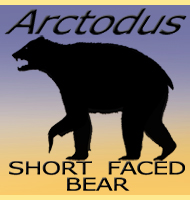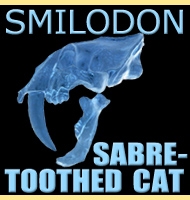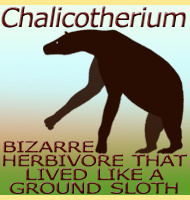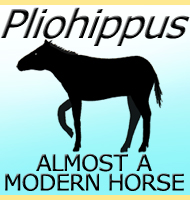


Ceratogaulus
a.k.a. Horned gopher
Name:
Ceratogaulus.
Phonetic: Seh-rat-o-gow-lus.
Named By: Matthew - 1902.
Synonyms: Epigaulus.
Classification: Chordata, Mammalia, Rodentia,
Mylagaulidae, Mylagaulinae.
Species: C. rhinocerus
(type), C. anecdotus, C. C. cornusaulax, C. cornutasagma, C.
hatcheri, C. minor.
Diet: Herbivore.
Size: About 30 centimetres long.
Known locations: USA, Kansas - Ogallala
Formation, Nebraska.
Time period: Langhian of the Miocene through to the
early Zanclean of the Pliocene.
Fossil representation: Multiple individuals are
known.
Ceratogaulus
was a relatively large rodent that lived in North America from about
15.97 to 4.9 million years ago. Ceratogaulus
is thought to
have been a fossorial animal, which means that it would have spent a
large portion of its time underground in burrows. The curious thing
about this genus though is that on top its head were two large horns
that pointed upwards. Before a review of some of the theories
regarding the presence of these horns and the purpose they fulfilled,
we need to consider two important facts about these horns. First,
the horns seem to have been on both male and female Ceratogaulus with
no noticeable difference between them, so sexual dimorphism can be
ruled out. Second, the horns of Ceratogaulus
that lived in the
later stages of the Miocene are situated further up the skull than
those of Ceratogaulus that lived earlier.
The
most tempting theory to go with is that the horns were burrowing aids
for digging. The obvious problem with this is that the horns are
simply in the wrong place. Burrowing animals usually dig and push
dirt out of the way with the snout, but the horns of Ceratogaulus
point up, not forwards. If an attempt to use them was made, the
snout of the animal would also get in the way of the excavation, and
when you remember that horns of later generations became positioned
further back towards the top of the skull, you can appreciate that
the snout would have become more and more of a hindrance as time went
on. It is far more likely that Ceratogaulus
relied more upon their
short but powerful forelimbs for earth moving.
Display
and inter species combat are also usually ruled out, firstly because
since both males and females had horns, there is no clear way for
them to identify one another. This leads to the second proposal of
males using them to fight one another over such things as mating rights
to females, perhaps in a similar manner to deer. This in turn leads
to comparison between Ceratogaulus with a modern
genus called Aplodonta
rufa, better known as the mountain beaver. The mountain
beaver is
noted for having poor eyesight, but the optic foramen (the opening
in the skull for the eye) of Ceratogaulus is
measured as being
between half and two thirds the size of the optic foramen of a mountain
beaver. It follows that by the same proportion the eyesight of
Ceratogaulus was a third to half as bad again as the
eyesight of a
mountain beaver, which leads to the idea that females would not be
able to identify winning males.
These
theories that are counter to the idea of the horn being for display do
actually have their own problems. Assuming that Ceratogaulus
had
eyesight so poor that they could not recognise individuals of their
species, the horns might still have been enabled them to not confuse
other similar sized animals for their own species. Even if they could
recognise not much more than a silhouette, a silhouette with a pair
of horns on its nose looks different to a silhouette without one.
Also, if males were fighting for dominance, the loser may have
been driven away from a specific harem of females, which means the
females would not have to recognise any individual in particular other
than the resident male, who in all likelihood would probably do the
identifying for them. This behaviour however is only speculation,
but it’s worthwhile to remember that animals can recognise each other
in other way such as smell, and this can also count against the
idea of the horns being just for display.
A
better theory to explain the presence of the two horns is that of
defence. By being on top of the snout, the horns would almost
always be facing in the general direction of a predator. At thirty
centimetres long, Ceratogaulus were not small
rodents, but they
would have been smaller and lower than most predators of the day.
So, if a predator such as say a bear
dog got curious about a
Ceratogaulus burrow, an individual inside may have
been able to
thrust its horn upwards into its snout. Likewise the horns would have
been an effective defensive weapons for a Ceratogaulus
caught above
ground, especially if it was aggressively standing its ground. One
quick thrust of the horns into the face or the throat of a predator,
and it might be surprised and disorientated just long enough for the
Ceratogaulus to escape, especially if the predator
was too young and
inexperienced to known how to tackle such animals.
Another burrowing mammal known to have had horns on top of its head is the xenarthran Peltephilus.
Further reading
- The evolution of fossoriality and the adaptive role of horns in the
Mylagaulidae (Mammalia: Rodentia), Samantha S. B. Hopkins
- 2005.
- A new species of Ceratogaulus from Nebraska and
the evolution of
nasal horns in Mylagaulidae (Mammalia, Rodentia, Aplodontioidea). -
Journal of Systematic Palaeontology. - Jonathan J. M. Calede &
Joshua X. Samuels - 2020.
----------------------------------------------------------------------------
Random favourites
 |
 |
 |
 |




